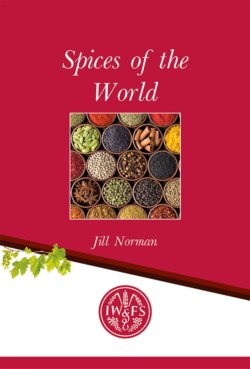Читать книгу Spices of the World - Jill Norman - Страница 4
На сайте Литреса книга снята с продажи.
ОглавлениеIntroduction
What are spices, where do they come from and how are they usually characterised?
The Oxford English Dictionary defines spices as “one or other of various strongly flavoured or aromatic substances of vegetable origin, obtained from tropical plants, commonly used in condiments”. Most spices are derived from tropical plants – from the roots, bark, seeds, buds and fruits, and are usually used in dried form, whether whole or ground.
Most of the important spice plants – cinnamon, cardamom, cloves, ginger, nutmeg and pepper – are native to tropical Asia, while allspice, chillies and vanilla come from the Americas. Many aromatic seeds, such as coriander, fenugreek, fennel and mustard, are from the Mediterranean basin, and Europe’s colder regions have contributed caraway, dill and juniper.
Complex aromas
Spices differ from herbs, which are usually green, fresh, aromatic plants that grow in relatively mild climates and are consumed fresh or dried. Some, such as garlic and horseradish, have similar strong flavours to those found in spices. Broadly speaking, herbs are the basis of much flavouring of European food, whereas almost all spices come from areas with hotter climates and therefore tend to feature prominently in cuisine from these regions.
“ The oleoresins contain the aroma profile of the plant, and provide the spice’s characteristic flavour ”
Our first impression of any food or drink comes through our eyes, then we smell the sometimes complex aromas and, finally, we taste. Four specific tastes can be detected in different parts of the mouth – sweet, sour, salty and bitter – and pungency can be detected in taste, too.
We smell spices as soon as we open the packaging, and later as the aromas develop in cooking. Tasting a dry spice, with few exceptions, is not rewarding, however we can appreciate their flavours in a cooked dish.
Characterising spices
The characteristic odour of spices derives from the volatile constituents in the plant material. The oleoresins, which can be drawn out by carbon dioxide extraction, contain the aroma profile of the plant. They provide the spice’s characteristic flavour, but the pungent principle – the hot sensation produced in the mouth by spices such as chillies, pepper or ginger – also contributes to flavour.
Our vocabulary for describing smell and taste is fairly limited; often they are described in terms of other aromas and flavours. When we are discussing spices, “aromatic” and “pungent” are commonly used words, but they don’t offer an accurate definition.
One group of spices could be defined as warm and earthy: saffron, cardamom, cumin, caraway and turmeric, for example. Within the group there are other aromas and flavours to detect. Saffron is musky, floral and penetrating; cardamom mellow and fruity, slightly camphorous; cumin spicy-sweet with a bitter note; and caraway bittersweet with a hint of anise. Turmeric, when fresh, has gingery, citrus aromas, but the dried version is citrus, musky and slightly bitter. Of course, different people have different perceptions when it comes to aromas and flavours.
Scientific developments
Today, food scientists use e-noses and e-tongues to make sensory evaluations of foods because they are more consistent than human noses and tongues. They collect headspace – aroma molecules, gathered from a range of spices, herbs and other foods, are reproduced in laboratories for use in ready-prepared foods. Flavour drops, originally developed for the NASA space food programme, are now available online in an extensive range of foods, including many spices. Concentrated natural spice and herb pastes are available, too. If you want to experiment, proceed cautiously – only one drop, heavily diluted, may be needed. The flavour profile of many of these drops and pastes is impressive, but many nutritive, tactile and cultural values are lost.
